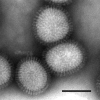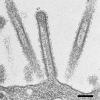Structure of influenza virus ribonucleoprotein complexes and their packaging into virions
- PMID: 20853340
- PMCID: PMC6029254
- DOI: 10.1002/rmv.666
Structure of influenza virus ribonucleoprotein complexes and their packaging into virions
Abstract
The influenza A virus genome consists of eight segmented, single-stranded, negative-sense RNAs. Each viral RNA (vRNA) segment forms a ribonucleoprotein (RNP) complex together with NPs and a polymerase complex, which is a fundamental unit for transcription and replication of the viral genome. Although the exact structure of the intact RNP remains poorly understood, recent electron microscopic studies have revealed certain structural characteristics of the RNP. This review focuses on the findings of these various electron microscopic analyses of RNPs extracted from virions and RNPs inside virions. Based on the morphological and structural observations, we present the architecture of RNPs within a virion and discuss the genome packaging mechanism by which the vRNA segments are incorporated into virions.
2010 John Wiley & Sons, Ltd.
Figures






References
-
- Palese P. Orthomyxoviridae. In: Knipe DM, Howley PM, Griffin DE, Lamb RA, Martin MA, Roizman B, Straus SE, editors. Fields virology. 5. Lippincott Williams & Wilkins; Philadelphia: 2007. pp. 1647–1689.
-
- Osterhaus AD, Rimmelzwaan GF, Martina BE, et al. Influenza B virus in seals. Science. 2000;288:1051–1053. - PubMed
-
- Guo YJ, Jin FG, Wang P, et al. Isolation of influenz C virus from pigs and experimental infection of pigs with influenza C virus. J Gen Virol. 1983;64:177–182. - PubMed
Publication types
MeSH terms
Substances
Grants and funding
LinkOut - more resources
Full Text Sources
Other Literature Sources

